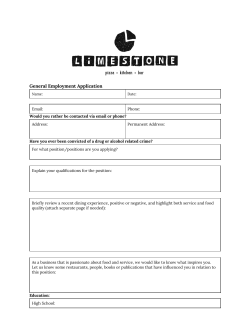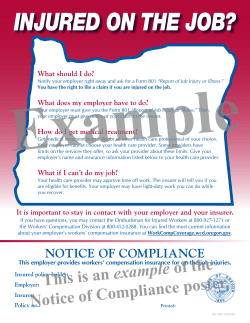
Nonqualified Deferred Compensation Plans
NQDC ~ Nonqualified Deferred Compensation Plans in brief Nonqualified Deferred Compensation A “deferred compensation plan” is generally an agreement where an employer promises to pay money or property to an employee in a future year (beyond the year in which the employee performs the services generating the compensation). They are often also called retirement or pension plans. • Q ualified. Some deferred compensation plans are “qualified” for special tax treatment under Internal Revenue Code (I.R.C) § 401 (e.g., current employer deduction without current employee income), but such qualified retirement or pension plans have contribution limits and carry burdensome requirements (e.g., generally have to be offered to most full-time employees). • N onqualified. A “nonqualified deferred compensation plan” (NQDC) does not qualify for special tax treatment under I.R.C. § 401, but NQDC plans generally have no contribution limits and generally have less burdensome requirements. • SERP / EDC. Deferred compensation plans can be SERPs and/or EDC plans. – Supplemental Executive Retirement Plan (SERP) is an arrangement where the employer A agrees to pay additional income to an employee upon a later event (e.g., death, disability, retirement). – An Elective Deferred Compensation Plan (EDC) is an arrangement where an employee defers a portion of current income until a later event (e.g., death, disability, retirement). Advantages of NQDC: • Employee is not taxed on income earned until some time in the future. • Employer can recruit and retain key employees by selectively choosing the participants of the plan. • B enefits can be designed as “golden handcuffs” to encourage key employees to continue to work for employer. • M ost employers can provide unlimited benefits in place of, or in addition to, those receivable under qualified pension or profit sharing plans. (Tax-exempt employers are subject to the additional requirements of I.R.C. § 457. Why Finance with Employer-Owned Life Insurance? • L ife insurance is likely the only vehicle that can assure that the funding will be complete at the death of the employee. • Life insurance generally accumulates on a tax-deferred basis. • Life insurance can be designed so that most employers recover their costs on a tax-free basis. While Employee is Working Life Insurance $ premiums paid by Employer Employer Insurance Co. NQDC Plan Employee • T he employer and employee enter into a written agreement, under which the employer agrees to pay employee or designated beneficiary deferred compensation benefits upon the employee’s death, disability, or retirement. • The agreement can be a SERP or EDC plan. • T he employer applies for, and is the owner and beneficiary of, a life insurance policy that insures the life of the employee. Payment ~ Employee’s Retirement Life Insurance Employer Insurance Co. Payment (could be in form of money and/or policy) Employee • U pon the employee’s retirement (or otherwise fulfilling the terms of the plan), the employer pays the employee the promised deferred compensation benefits. • Payment can take several forms: – Could be lump sum or stream of payments over multiple years. – Could be property (e.g., transfer of policy ownership to employee). – Could be cash. • If employer keeps ownership of policy, it can: –withdraw from the policy in tax-favored manner (surrender up to basis, borrow) to have the funds to pay the benefits. –recover cost of implementing the plan from the life insurance policy, either through cash value or ultimate death benefit. Payment ~ Employee’s Death While Working Death benefit under life insurance policy Employer Insurance Co. Death benefit under NQDC plan Employee’s estate Employee’s beneficiary(ies) • I f the employee passes away while the plan is in place, and if the plan promises a death benefit, the life insurance proceeds can be used by the employer to pay the employee’s beneficiaries. • Payment upon death is usually (but not always) in a lump sum. • G enerally, the death benefit paid from the life insurance policy is income tax-free to the employer, but then this amount is income taxable (as compensation) when paid to the employee’s beneficiaries under the NQDC plan. • I f the parties prefer to have the death benefit go to the employee’s beneficiaries income-tax free, then they should generally also enter into a separate endorsement split dollar agreement. Tax Consequences To the Employer • A mounts set aside to informally fund a plan (e.g., premiums paid) are not deductible by the employer. I.R.C. §§ 264(a)(1), 404(a)(5). • T he cash value increases in the life insurance are not taxable to the employer unless they are subject to the corporate Alternative Minimum Tax. I.R.C. §§ 72, 55, 56(g). • Death proceeds paid to the employer are normally not taxable. Exceptions include: – I f the death proceeds are subject to the corporate Alternative Minimum Tax. I.R.C. §§ 101, 55, 56(g). –If the employer failed to obtain written notice and consent before the policy was issued. I.R.C. § 101(j). • T o the extent benefits are reasonable compensation to the employee, they are deductible by the employer when they are received by the recipient. I.R.C. §§ 83, 162(a)(1), 404(a)(5). To the Employee/Beneficiary • G enerally, as long as the right to receive payment is unfunded and unsecured, benefits will not be includible in the gross income of the employee or designated beneficiary until they are received. I.R.C. §§ 61, 83, 409A; Revenue Ruling 60-31. • Compensation received, including death benefits, are taxed at ordinary income tax rates. Id. • A lso, I.R.C. § 409A imposes extra requirements on most NQDC plans (unless the plan was vested before the end of the year 2004). – The plan must be in writing. This has always been good practice anyway. – There are rules regarding initial deferral elections. – T he plan can permit only certain payment triggers: (i) separation from service; (ii) time or a fixed schedule; (iii) death; (iv) disability; (v) change of control of employer; and/or (vi) unforeseeable emergency. These triggers have been common under NQDC plans even before I.R.C. § 409A. – Payment cannot be triggered by poor financial health of the employer, and accelerations of the time of payment are generally prohibited. • V iolating I.R.C. § 409A causes tax to the employee (i) on any vested amounts, plus (ii) a 20% additional penalty, plus (iii) interest from the date of vesting. • As long as I.R.C. § 409A is obeyed, it does not change rules regarding the timing of tax. Other Consequences Employment Taxes, Social Security, and W-2 Reporting • B enefits are subject to FICA and FUTA withholding at the later of when the services are performed or when they are no longer subject to a substantial risk of forfeiture. I.R.C. §§ 3121(v)(2)(A), 3306(r)(2)(A). • G enerally, benefits should not reduce Social Security benefits paid to an employee. Social Security Act § 209(m)(2). • A mounts deferred are subject to W-2 (or 1099) reporting, even though the amounts are not currently includible in income. ERISA • N onqualified deferred compensation plans are frequently considered a “pension plan” under the Employee Retirement Income Security Act (ERISA) because they provide retirement income. Accordingly, certain ERISA requirements normally apply. • To avoid the more onerous requirements of ERISA: – t he plan must be primarily for a select group of management or highly-compensated employees. 29 Code of Federal Regulations (C.F.R.) § 2520.104-23. – The plan must be unfunded. Id. – A letter must be filed with the Department of Labor within 120 days after the plan becomes effective. Id. If the letter is not filed, full ERISA reporting and disclosure is required. – The plan must include a claims procedure. 29 C.F.R. § 2560.503-1. This publication is not intended as legal or tax advice; nonetheless, Treasury Regulations might require the following statements. This information was compiled by The Northwestern Mutual Life Insurance Company. It is intended solely for the information and education of Northwestern Mutual’s financial representatives, their customers, and the legal and tax advisors of those customers. It must not be used as a basis for legal or tax advice, and is not intended to be used and cannot be used to avoid any penalties that may be imposed on a taxpayer. Northwestern Mutual and its financial representatives do not give legal or tax advice. Taxpayers should seek advice regarding their particular circumstances from an independent legal, accounting, or tax advisor. Tax and other planning developments after the original date of publication may affect these discussions. – To comply with Circular 230 Copyright © 2012 by The Northwestern Mutual Life Insurance Company, Milwaukee, Wisconsin www.northwesternmutual.com 22-3889 (1012)
© Copyright 2025









